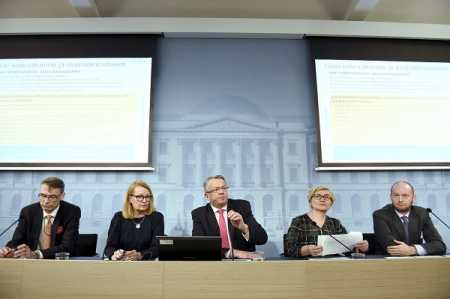Tue, 10 Nov, 2015 02:37:11 AM Government details Sote reform FTimes Report, Nov 10  Secretary Tuomas Pöysti (from left .) Ministers Lenita Toivakka, Juha Rehula and Anu Vehviläinen and Perussuomalaiset parliamentary group chair Sampo Terho at the governmemt press conference on Sote reform on Monday. Photo Lehtikuva. The government on Monday disclosed detail information about the social and healthcare (Sote) reforms including the number of the autonomous regions in the new system.
There will be 18 autonomous regions in the country, of which 15 will organise healthcare and social services in their area themselves, said an official press release.
Under the new legislation, the remaining three regions will provide the services with the support of one of the other autonomous regions.
Besides healthcare and social services, other duties will also be brought together under the autonomous regions.
Public administration in Finland will be organised on three-tier levels of central government, autonomous regions and local government.
With these functions being transferred from nearly 190 different designated authorities to 18 autonomous regions, the number of joint statutory organisations, namely different local authorities and healthcare and social welfare service providers, will be markedly reduced.
The existing divisions will be used as basis for dividing the country into autonomous regions.
Responsibility for the organisation of healthcare and social services will be transferred from joint municipal authorities and local authorities to the autonomous regions on 1 January, 2019.
Where an autonomous region deems its resource capacity insufficient for organising healthcare and social services, it will be possible to seek government approval to arrange the services in cooperation with another autonomous region.
The government will make the provision of healthcare and social services more versatile. Each autonomous region will provide the necessary healthcare and social services itself or together with other autonomous regions, or may use the services of the private sector or the third sector.
The autonomous regions must evaluate the expediency of providing services themselves in relation to the service provision of the private sector and the third sector as well as those provided in collaboration with other regions.
Quality and cost data on services provided by the regions themselves and those provided by private service providers must be made public in a commensurate way.
Procedures will be prepared to make sure that new service providers and small and medium-sized enterprises can provide the services.
There will be units operating on a broad basis round the clock in 12 hospitals. All the other existing central hospitals will offer a more limited range of 24-hour services and will provide specialised services.
This way there will also be 24-hour A&E services in different parts of the country in the future.
The existing multisource financing will be simplified and customers will be given more freedom of choice. The preparation will begin in November 2015.
During the reform process, the government will decide on the organisation of healthcare and social welfare services. These decisions will be made on the basis of proposals presented by the autonomous regions and after consulting the regions.
The decision on the organisation of healthcare and social welfare services will include a public service pledge and strategic development goals. Additionally, the Government will decide on the duties and division of responsibilities between the national and regional specialised units, university hospitals and other centres of expertise.
The Government will also be in charge of steering the production structure and any large investments, and will safeguard the execution of freedom of choice.
A council elected by direct vote will exercise the highest decision-making power in each autonomous region.
In addition to the duties in healthcare and social welfare services, the autonomous regions will also be responsible for rescue services, the duties of the regional councils, the duties of the Centres for Economic Development, Transport and the Environment within the scope of regional development, and possibly environmental healthcare.
In January 2016, the Government will in decide on the preparation of the regional government reform package and on the duties to be transferred to the autonomous regions. Decisions will also be made on given regional duties that might be transferred to local authorities.
The Ministry of the Interior, the Ministry of Employment and the Economy, the Ministry of Social Affairs and Health, the Ministry of Agriculture and Forestry, the Ministry of Education and Culture, the Ministry of Transport and Communications and the Ministry of the Environment will each assess the duties to be transferred to the autonomous regions and how the transfers should be carried out.
The Ministry of Finance and the Project Manager leading the reform package will coordinate the reports of the ministries for Government decision-making.
More News
|
|
Finland Times
| Thursday, 01 January, 2026 |

